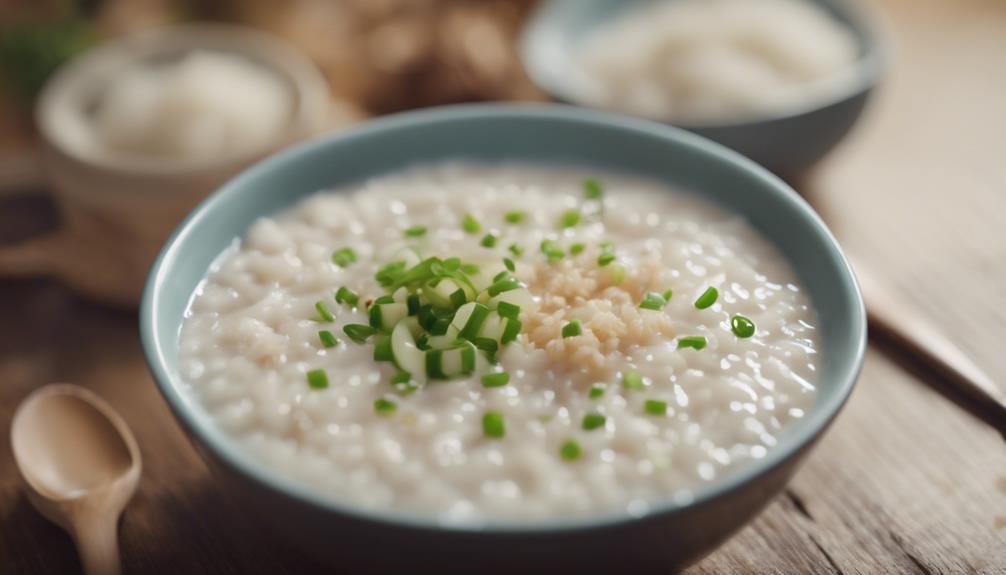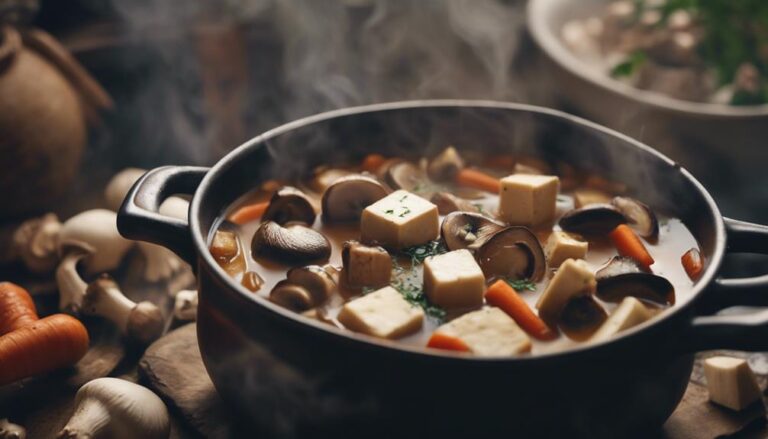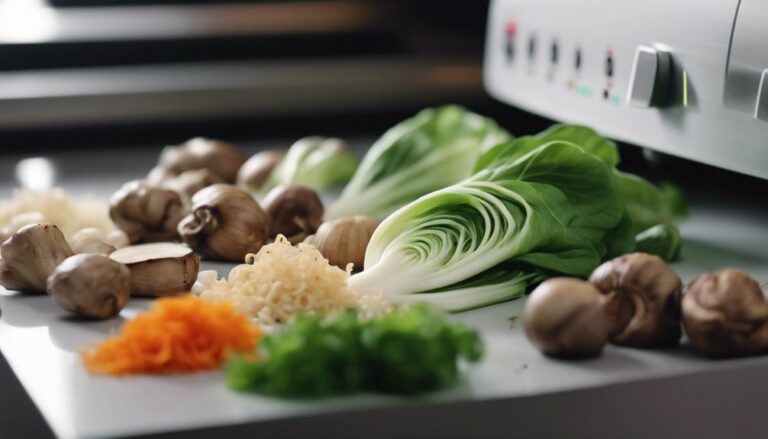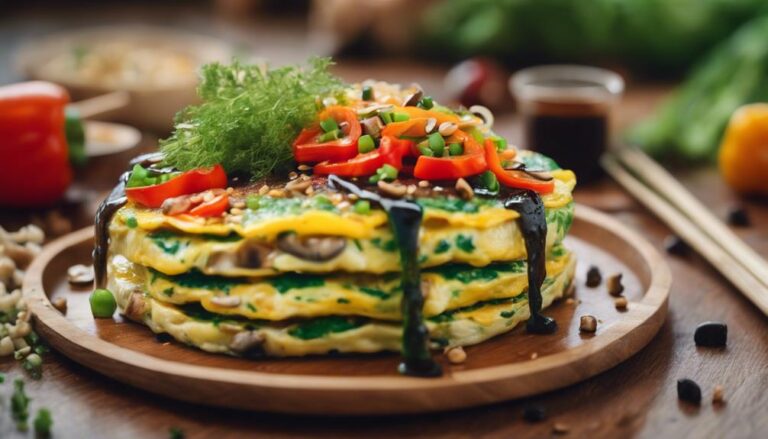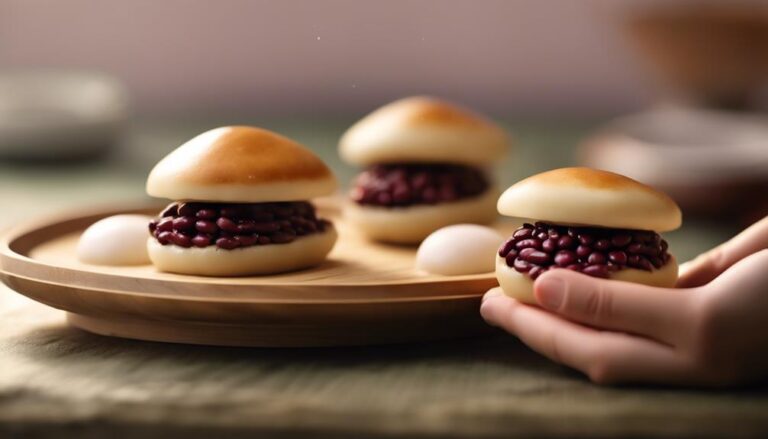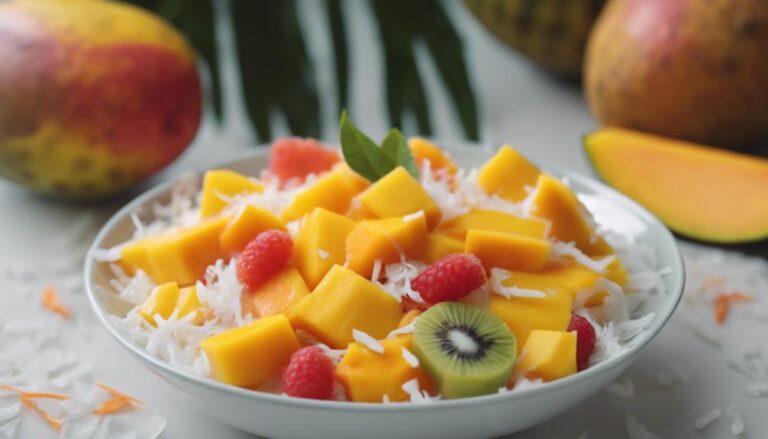Sous Vide Rice Porridge With Ginger and Scallions: a Warming Breakfast
For a comforting breakfast, try sous vide rice porridge with ginger and scallions. This dish blends warmth and flavor seamlessly. Rice porridge, also known as congee, carries a rich history and cultural significance worldwide. The key components, ginger, and scallions, add a zesty kick and freshness. Control consistency by finely chopping ingredients and balancing liquid and rice. Experiment with ingredient influences for unique textures. Adjust cooking time for desired smoothness. Elevate your breakfast with this satisfying, nutrient-rich dish. Further insights and variations await exploration.
What You Will Learn Here
- Sous vide method ensures precise temperature control for velvety rice porridge.
- Ginger adds zesty warmth, while scallions bring freshness to the dish.
- Customizable ingredients enhance nutrition and flavor profile.
- Experiment with coconut milk or miso paste for creaminess.
- Perfect balance of short-grain and long-grain rice for desired consistency.
Origin of Rice Porridge
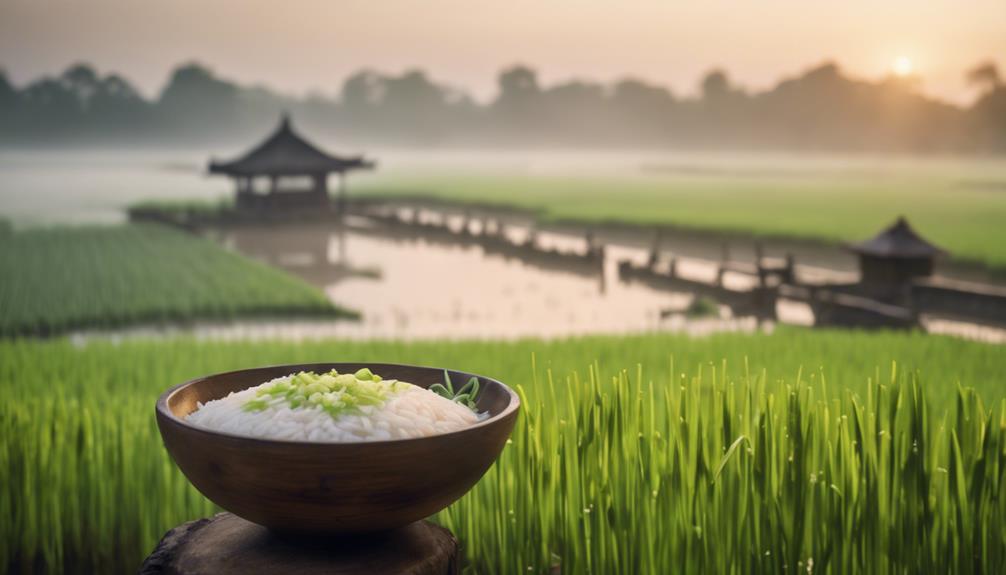
Rice porridge, also known as congee, has a rich history that dates back centuries. It holds cultural significance in many Asian countries, where it's often considered a comfort food.
Beyond its comforting appeal, rice porridge offers a range of nutritional benefits, making it a popular choice for a hearty and wholesome meal.
History of Porridge
Porridge, originating from ancient civilizations, has been a staple comfort food enjoyed around the world for centuries. The evolution of porridge spans diverse cultures and regions, with each adding its unique twist to this simple yet satisfying dish.
From the creamy rice porridge of Asia to the hearty oat porridge of Europe, this dish has played a significant role in culinary history. The cultural impact of porridge is profound, often symbolizing warmth, nourishment, and care. In many societies, porridge is a symbol of hospitality and compassion, often served to guests as a gesture of welcome.
Its versatility allows for endless variations, making it a favorite breakfast choice for those seeking a wholesome start to the day. Over time, porridge has evolved from a basic sustenance food to a culinary delight enjoyed by people of all ages and backgrounds. Its ability to adapt to different palates and dietary preferences has cemented its status as a beloved comfort food worldwide.
Cultural Significance
Explore the cultural roots and significance of rice porridge, tracing its origins back to ancient traditions that have shaped its role in culinary heritage. Rice porridge, known by various names like congee in China, juk in Korea, and okayu in Japan, holds a special place in cultural traditions and breakfast customs across Asia. This comforting dish isn't just a meal but a symbol of warmth and care, often associated with healing properties and nourishment.
In many Asian societies, rice porridge is a staple comfort food that brings families together. Passed down through generations, family recipes for rice porridge are cherished and reflect the essence of home-cooked meals. It's a dish that transcends social boundaries, enjoyed by people from all walks of life, whether for breakfast, as a soothing remedy for the sick, or simply as a hearty meal shared among loved ones.
The cultural significance of rice porridge lies in its ability to provide sustenance, comfort, and a connection to cultural heritage through shared meals and cherished family traditions.
Nutritional Benefits
Begin a journey delving into the nutritional benefits of this ancient dish, tracing its roots back to the origins of rice porridge.
Rice porridge, also known as congee, holds a rich history of being a comforting and nourishing meal across various cultures. The health benefits of rice porridge are vast, making it a popular choice for those seeking a wholesome and balanced breakfast option.
One of the key nutritional benefits of rice porridge is its easy digestibility, which can be gentle on the stomach, making it suitable for individuals with sensitive digestive systems. The cooking methods used to prepare rice porridge help to break down the grains, making it easier for the body to absorb essential nutrients like carbohydrates and proteins.
Furthermore, rice porridge can be customized with ingredients like ginger and scallions, adding not only flavor but also additional health benefits. Ginger is known for its anti-inflammatory properties, while scallions provide essential vitamins and minerals.
Key Porridge Components
Consider incorporating essential ingredients like ginger and scallions to enhance the flavor profile of your sous vide rice porridge. These key components not only add a depth of flavor but also provide nutritional benefits that complement the creamy texture of the porridge.
Here are three key porridge components to elevate your breakfast experience:
- Ginger: The warming spice of ginger adds a zesty kick to your porridge, providing an invigorating contrast to the richness of the rice. Its aromatic qualities bring a comforting element to the dish, perfect for starting your day on a cozy note.
- Scallions: Adding scallions brings a subtle onion flavor and a hint of freshness to the porridge. The green onions provide a pop of color and a mild bite that balances the overall taste, making each spoonful a delightful blend of flavors.
- Soy Sauce: A dash of soy sauce can deepen the savory notes of your porridge, enhancing the umami taste profile. This ingredient adds a savory complexity that ties all the flavors together harmoniously, creating a well-rounded breakfast dish that's both satisfying and nourishing.
Top Porridge Variations
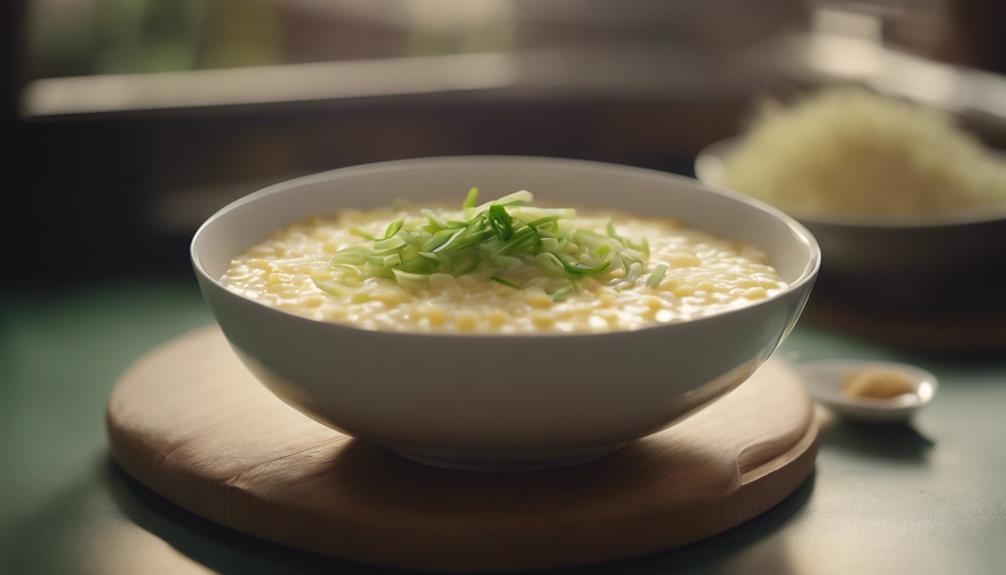
When considering top porridge variations, one standout choice is the ginger-infused rice porridge recipe. This flavorful twist adds a warm and aromatic element to the classic dish, elevating its taste profile.
Give this variation a try for a comforting and nourishing meal that's perfect for any time of day.
Ginger-infused Rice Porridge Recipe
To elevate your rice porridge experience, infuse it with the warming flavors of ginger for a delicious twist on this classic dish. Ginger adds a zesty kick that complements the creamy texture of the porridge, creating a comforting and flavorful bowl.
Here's how you can make your own ginger-infused rice porridge:
- Ingredients:
- Long-grain rice
- Fresh ginger
- Water or broth
- Cooking Technique:
- Start by grating or finely chopping the ginger to release its aromatic oils.
- Cook the rice in water or broth until it reaches a porridge-like consistency.
- Add the ginger to the porridge and simmer gently to infuse the flavors.
- Flavor Combination:
- The spiciness of ginger pairs well with savory toppings like scallions or soy sauce.
- For a sweeter variation, try adding a touch of honey or brown sugar.
- Experiment with different ratios of ginger to find your preferred level of heat in the porridge.
Enjoy this ginger-infused rice porridge as a warming and nourishing breakfast option that will surely delight your taste buds!
Porridge Texture Enhancement
When considering porridge texture enhancement, you'll want to decide between a creamy or chunky consistency for your dish.
To control the consistency, tips like adjusting cooking time or adding more liquid can be helpful.
Keep in mind that the ingredients you choose, such as different types of rice or the amount of water used, can greatly influence the final texture of your porridge.
Creamy Vs. Chunky
For a satisfying twist on traditional rice porridge, consider experimenting with achieving either a creamy or chunky texture to elevate your dining experience.
When considering flavor preferences, a creamy porridge tends to blend ingredients together, creating a smooth and consistent taste throughout each bite. This texture is often achieved by stirring continuously during cooking, using a higher liquid-to-rice ratio, or incorporating ingredients like coconut milk for richness.
On the other hand, if texture preferences lean towards a chunkier consistency, using less liquid and allowing the rice to retain more of its individual grains can provide a heartier mouthfeel. Adding ingredients like diced vegetables, shredded chicken, or crispy bacon can enhance the chunky porridge experience.
Cooking techniques play an essential role in achieving the desired texture, whether through slow simmering for creaminess or shorter cooking times for a chunkier result. Experimenting with ingredient combinations and adjusting cooking methods can help you find the perfect balance between creamy and chunky textures in your rice porridge.
Consistency Control Tips
Enhance the texture of your rice porridge by implementing these consistency control tips. To achieve a creamy consistency in your porridge, consider adjusting your cooking techniques and ingredient ratios.
When using a sous vide method, precise temperature control is vital to guarantee the rice cooks evenly and becomes tender. This method allows the rice to slowly absorb the liquid, resulting in a smoother texture.
Experiment with different flavor profiles by adding ingredients like ginger and scallions for a delightful twist. These aromatic additions not only enhance the taste but also contribute to the overall texture of the porridge. Remember to finely chop these ingredients to make sure they blend seamlessly into the porridge, adding bursts of flavor in every spoonful.
Maintaining the right balance of liquid to rice is essential for achieving the desired consistency. Be mindful of the cooking time and temperature to prevent the porridge from becoming too thick or runny. By paying attention to these details, you can create a velvety smooth rice porridge that's both comforting and satisfying.
Ingredient Influence Insights
To elevate the texture of your rice porridge, consider how different ingredients can influence its overall consistency and mouthfeel. Flavor combinations like coconut milk or miso paste can add creaminess, while using a mix of short-grain and long-grain rice can create a balanced thickness. Cooking techniques such as blending a portion of the porridge or adding a dollop of yogurt at the end can enhance its silkiness.
Seasonal variations like incorporating fresh fruits in the summer or roasted squash in the fall can provide both texture and flavor contrasts. Additionally, experimenting with different grains like quinoa or steel-cut oats can offer diverse textures and added health benefits.
Final Thoughts
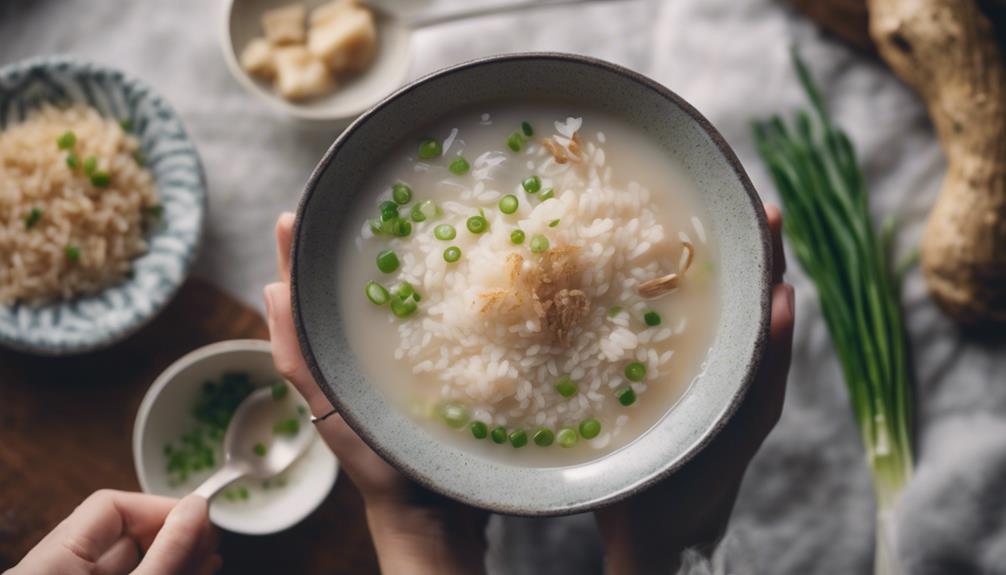
Considering the delightful flavors and comforting textures of this sous vide rice porridge, you'll find it to be a satisfying and nourishing dish perfect for any time of day. Reflection on your cooking journey with this recipe may lead you to realize the versatility of porridge as a meal beyond just breakfast.
The subtle warmth of ginger combined with the freshness of scallions creates a harmonious balance that appeals to a wide range of palates.
If you're looking to make some recipe tweaks, consider experimenting with different toppings such as toasted nuts, fried shallots, or a drizzle of sesame oil to add your own personal touch. Additionally, adjusting the cooking time slightly to achieve a thicker or thinner consistency can cater to your preferred porridge texture.
Remember that cooking is a creative process, so feel free to adapt the recipe to suit your taste preferences.
Frequently Asked Questions
Can I Use a Slow Cooker Instead of a Sous Vide Machine?
Yes, you can use a slow cooker as an alternative to a sous vide machine. Remember, slow cookers work differently by simmering food at a consistent low temperature. Adjust cooking times accordingly and enjoy the convenience of slow cooker cooking tips.
How Can I Make This Rice Porridge Vegan-Friendly?
To make the rice porridge vegan-friendly, swap dairy milk for plant-based alternatives like almond or coconut milk. Use vegetable broth instead of chicken broth. Experiment with vegan flavorings like miso paste or nutritional yeast for added depth.
Can I Substitute Ginger With Another Spice?
If you're looking to switch up the flavors in your recipe, try alternative spices like cinnamon or nutmeg. These spices offer warm, comforting notes that can complement the dish's creamy texture. Experiment for delightful variations!
What Type of Rice Is Best for Making Porridge?
For making porridge, brown rice is hearty and nutritious. Arborio creates a creamy texture. Jasmine and Basmati offer fragrant options. Experiment with different types to find your favorite balance of flavor and consistency.
Can I Freeze Leftover Porridge for Later Consumption?
Yes, you can freeze leftover porridge for later. To maintain best texture and flavor, portion it out before freezing. When reheating, consider adding a splash of liquid and stirring well to restore its creamy consistency.
Conclusion
To wrap up, sous vide rice porridge with ginger and scallions is a comforting and nourishing breakfast option that can be easily customized to suit your taste preferences.
By utilizing the sous vide method, you can achieve a perfectly creamy and flavorful porridge every time.
Experiment with different toppings and seasonings to create your own unique variations of this classic dish.
Enjoy this warming breakfast to start your day on a delicious and satisfying note.
